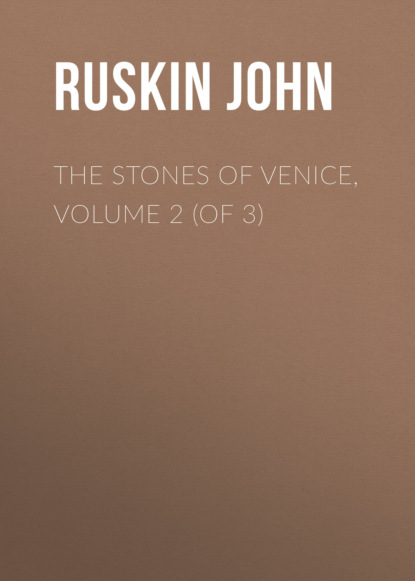 Полная версия
Полная версияThe Stones of Venice, Volume 2 (of 3)
141
The transformation of a symbol into a reality, observe, as in transubstantiation, is as much an abandonment of symbolism as the forgetfulness of symbolic meaning altogether.
142
On the window of New College, Oxford.
143
Uniting the three ideas expressed by the Greek philosophers under the terms ϕρόνηἔι, σοφία, and ἐπιστήμη; and part of the idea of σωφροσονη.
144
Isa. lxiv. 5.
145
I can hardly think it necessary to point out to the reader the association between sacred cheerfulness and solemn thought, or to explain any appearance of contradiction between passages in which (as above in Chap. V.) I have had to oppose sacred pensiveness to unholy mirth, and those in which I have to oppose sacred cheerfulness to unholy sorrow.
146
“Desse,” seat.
147
Usually called Charity: but this virtue in its full sense is one of the attendant spirits by the Throne; the Kindness here meant is Charity with a special object; or Friendship and Kindness, as opposed to Envy, which has always, in like manner, a special object. Hence the love of Orestes and Pylades is given as an instance of the virtue of Friendship; and the Virgin’s, “They have no wine,” at Cana, of general kindness and sympathy with others’ pleasure.
148
The “Faerie Queen,” like Dante’s “Paradise,” is only half estimated, because few persons take the pains to think out its meaning. I have put a brief analysis of the first book in Appendix 2, Vol. III.; which may perhaps induce the reader to follow out the subject for himself. No time devoted to profane literature will be better rewarded than that spent earnestly on Spenser.
149
I have given one of these capitals carefully already in my folio work, and hope to give most of the others in due time. It was of no use to draw them here, as the scale would have been too small to allow me to show the expression of the figures.
150
Lord Lindsay, vol. ii. p. 226.
151
Lord Lindsay, vol. ii. letter IV.
152
Selvatico states that these are intended to be representative of eight nations, Latins, Tartars, Turks, Hungarians, Greeks, Goths, Egyptians, and Persians. Either the inscriptions are now defaced or I have carelessly omitted to note them.
153
The comma in these inscriptions stands for a small cuneiform mark, I believe of contraction, and the small s for a zigzag mark of the same kind. The dots or periods are similarly marked, on the stone.
154
Can they have mistaken the ISIPIONE of the fifth side for the word Isidore?
155
Compare the speech of the Doge Mocenigo, above,—“first justice, and then the interests of the state:” and see Vol. III. Chap. II. § LIX.
156
Some further details respecting these portions, as well as some necessary confirmations of my statements of dates, are, however, given in Appendix 1, Vol. III. I feared wearying the general reader by introducing them into the text.
157
Many persons, capable of quickly sympathizing with any excellence, when once pointed out to them, easily deceive themselves into the supposition that they are judges of art. There is only one real test of such power of judgment. Can they, at a glance, discover a good picture obscured by the filth, and confused among the rubbish, of the pawnbroker’s or dealer’s garret?
158
This is easily explained. There are, of course, in every place and at all periods, bad painters who conscientiously believe that they can improve every picture they touch; and these men are generally, in their presumption, the most influential over the innocence, whether of monarchs or municipalities. The carpenter and slater have little influence in recommending the repairs of the roof; but the bad painter has great influence, as well as interest, in recommending those of the picture.
159
I do not like to hear Protestants speaking with gross and uncharitable contempt even of the worship of relics. Elisha once trusted his own staff too far; nor can I see any reasonable ground for the scorn, or the unkind rebuke, of those who have been taught from their youth upwards that to hope even in the hem of the garment may sometimes be better than to spend the living on physicians.
160
Casa Tiepolo (?) in Lazari’s Guide.
161
I do not think that there is anything more necessary to the progress of European art in the present day than the complete understanding of this sanctity of Color. I had much pleasure in finding it, the other day, fully understood and thus sweetly expressed in a little volume of poems by a Miss Maynard:
“For still in every land, though to Thy nameArose no temple,—still in every age,Though heedless man had quite forgot Thy praise,We praised Thee; and at rise and set of sunDid we assemble duly, and intoneA choral hymn that all the lands might hear.In heaven, on earth, and in the deep we praised Thee,Singly, or mingled in sweet sisterhood.But now, acknowledged ministrants, we come,Co-worshippers with man in this Thy house,We, the Seven Daughters of the Light, to praiseThee, Light of Light! Thee, God of very God!”A Dream of Fair Colors.These poems seem to be otherwise remarkable for a very unobtrusive and pure religious feeling in subjects connected with art.



